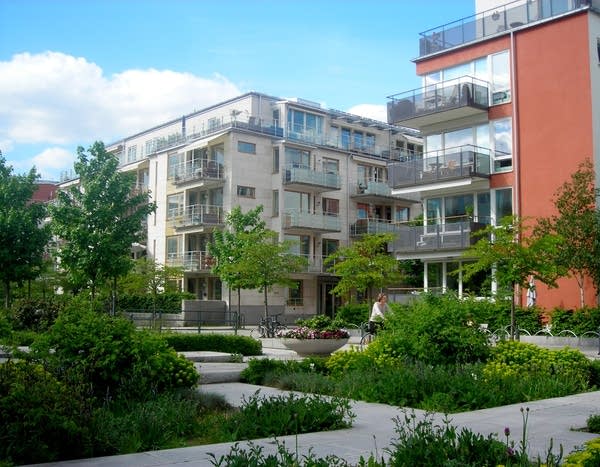Swedish town takes sustainability to new level

A town in Europe has figured out a solution for a problem that vexes Minnesota and communities all over the world -- what to do with garbage.
Hammarby Sjostad, a suburb of Stockholm, has practically eliminated garbage, by taking recycling to extremes. But it happens with no extra trouble for residents -- the waste-to-energy systems are all built-in.
The city handles its waste like something from a science fiction story. It's like a giant whole-house vacuum cleaner, only it clears waste from the entire town.
Each apartment building has a built-in receptacle with three openings for different kinds of waste.
Create a More Connected Minnesota
MPR News is your trusted resource for the news you need. With your support, MPR News brings accessible, courageous journalism and authentic conversation to everyone - free of paywalls and barriers. Your gift makes a difference.
At the visitors center, information officer Malena Karlsson explains the three categories.
"Food waste, combustible waste, and newspaper are the three main components of Swedish household waste," she says.
Once or twice a day, the waste is sucked through underground pipes at 40 miles an hour to a nearby processing plant.

The combustible waste, including non-recyclable plastic, is burned to produce heat and electricity. The newspapers are recycled, and the food waste is composted.
Other recyclables are collected in bins in each apartment building. Cans, bottles, and boxboard are the only items that must be collected by truck.
The community also uses its water waste creatively. The sewage treatment plant does the usual job of separating liquids from solids, or sludge. But here, the sludge is used to produce biogas, which is piped to kitchen stoves in the neighborhood, and also used in city buses.
And then there's the waste water. It's clean enough after treatment to be released back to the environment, but it's quite warm. The water goes out in the radiators, heating the apartments in Hammarby Sjostad and other areas, explains Karlsson.

After the heat is removed from the waste water, that same water is cold enough to use again in a district cooling system. Not for air conditioning in Sweden, but for offices with computer rooms and grocery store coolers.
So it's used twice before it's let out into the Baltic Sea.
This isn't government-subsidized efficiency. The apartments are built by private developers, they share the investment in the waste system, and the costs are comparable to living in downtown Stockholm. About 19,000 people live here, and the town is still growing.
Planners insist that all the city agencies work together to achieved the ambitious goals of 50 percent less energy use, and 50 percent less water use, compared to other Swedish households. One agency's waste becomes another agency's resource.

Hammarby Sjostad is a town of apartments, built when Sweden was vying to host the Olympic games. Sweden didn't make the Olympic cut, but the city of Stockholm went ahead to develop a neighborhood where as much as half the energy would come directly from the people who live there.
As ambitious as that sounds, the area looks pretty much like any modern Swedish neighborhood. The buildings are well-insulated, and lots of windows let in natural light. Some roofs sport solar collectors; others have green plants growing on them.
On the main street, shops and businesses occupy the ground floors, with apartments above. A commuter train whisks you to the subway. Downtown Stockholm is about 15 minutes away.
There's also a free ferry to Stockholm. Hammarby Sjostad is right by the water; the name means city-by-the-sea. Residents have easy access to their pleasure boats, docked in the canal.

On the other hand, private cars are discouraged: there's less than one parking space per apartment. The goal is for 80 percent of residents to use public transportation. Many residents are members of a car-sharing club that has 25 cars at its disposal.
As a result, the side streets are usually free of traffic. All the apartments have balconies overlooking a square or small playground.
That quiet atmosphere has attracted a lot of young families.
On a warm summer day, Asa Kasberg is watching 4-year-old Luisa playing in a big fountain that's the centerpiece of a tree-lined plaza.
"This is my husband's daughter, Luisa," Kasberg says. "We call her my 'bonus child.'"

Luisa is in bilingual daycare here, and Kasberg and her husband moved here mostly to be close to the child.
She gets around on the commuter train and subway, but her husband's job is on the other side of Stockholm, so he drives to work. He has to pay tolls to drive through the city. They're not happy about the long commute and what it means for the environment.
"It's hard to make those family decisions and environment decisions at the same time," Kasberg says.
Still, she's proud of the energy efficiency and careful use of resources at Hammarby Sjostad.
"In our days, when we have a car and all this stuff that damages the environment, at least you feel like you're doing something," she says.
